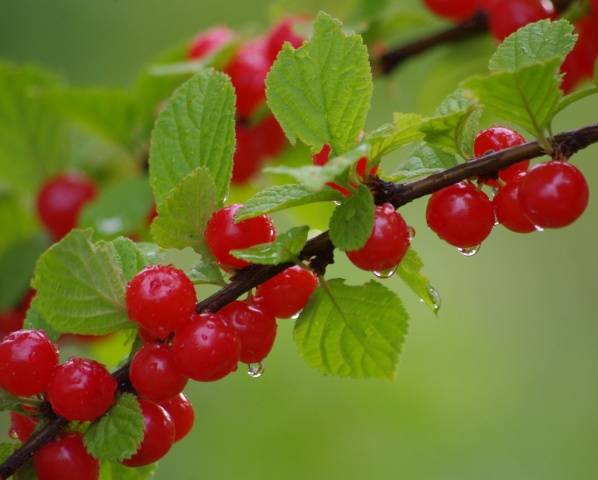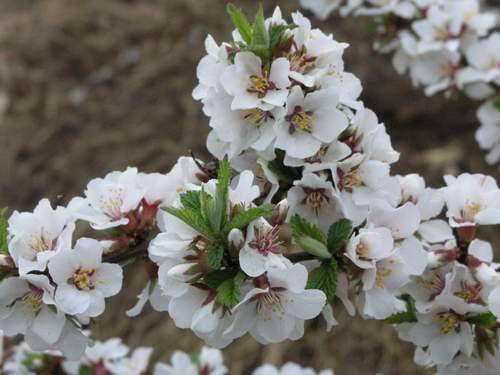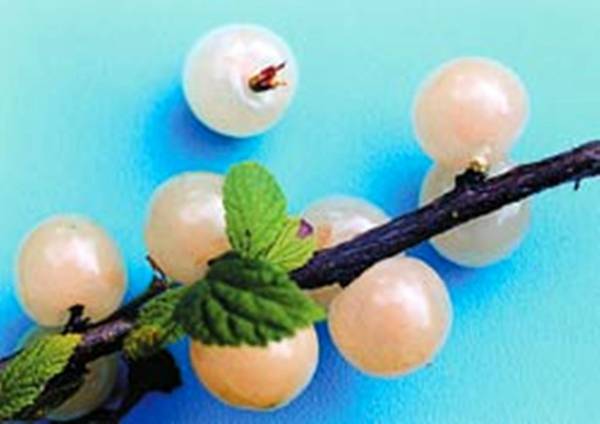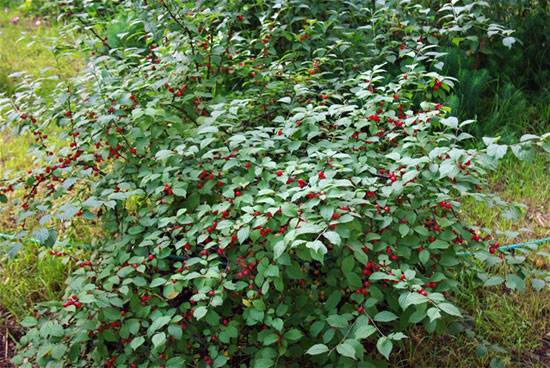Content
- 1 general description
- 2 Features of cultivation
- 3 Main problems
- 4 Recommendations for choosing varieties
- 5 Varieties of felt cherries for the Moscow region
- 6 Varieties of felt cherries for Siberia and the Urals
- 7 How to choose felt cherry for the Leningrad region
- 8 The best varieties of felt cherries
- 9 Reviews
According to the scientific classification, Felt Cherry (Prunus tomentosa) belongs to the genus Plum, it is a close relative of all representatives of the Cherry subgenus, peaches and apricots. The plant is native to China, Mongolia, and Korea. Southern Kyrgyzstan is also home to the wild felt cherry shii or chiya, as the locals call it.
The plant came to Russia at the end of the 19th century from Manchuria, took root in the Far East, and from there moved to other cold regions of the country, the European part, Belarus and Ukraine. Of the breeders, Michurin was the first to pay attention to the Chinese felt cherry. He became interested in its unprecedented frost resistance and stability of fruiting. This distinguished the species from other cherries and made it possible to cultivate it in harsh climates.
general description
Felt cherry is a small tree or shrub with several trunks from 150 to 250 cm in height. Some varieties, with high cultivation, can grow up to 300 cm. The plant owes its name to its pubescent shoots, leaves, and often berries. Externally, felt cherry is very different from ordinary cherry. Its leaves are small, highly corrugated and covered with soft fluff; young shoots are greenish-brown.
Flowers can be white or all shades of pink. In spring, they appear earlier or simultaneously with the leaves and cover the bush so abundantly that it looks like a huge bouquet. Felt cherry berries are small, with a diameter of 0.8 to 1.5 cm, occasionally 3 cm (hybrid with cherries). They are attached to short stalks and look like pink, red, and in some varieties almost black beads.
The taste of the berries is sweet, fresh, absolutely without bitterness or astringency. Sourness may be present, often mild, less often pronounced. The oblong, pointed bone is not separated from the pulp. It is almost impossible to pick a felt cherry without damaging the juicy berries, which is why its transportability is low. In recent years, varieties with cartilaginous, elastic pulp have been created. Productivity varies greatly depending on the variety, weather conditions, care and ranges from 3 to 14 kg per bush.
Felt cherry begins to bear fruit early:
- grown from seed - for 3-4 years;
- obtained from cuttings - 2-3 years after planting;
- vaccinated - next year.
The berries ripen about a week earlier than those of other species - steppe, sandy, ordinary.
Features of cultivation
Most Chinese cherry varieties require cross-pollination.Therefore, you need to plant several varieties, or place a plum or apricot nearby. There are also self-pollinating varieties of felt cherries.
The plant can withstand frosts up to 40 degrees, prefers sunny places and absolutely cannot tolerate stagnation of water at the roots. After full ripening, the berries stay on the bush without losing their attractiveness and taste for a very long time. Felt cherry is resistant to the scourge of other species - coccomycosis. It bears fruit well every year, but requires regular sanitary and formative pruning.
More tips on growing this crop will be given in a video about felt cherries:
Main problems
Cultivating Chinese cherries is fraught with some difficulties. In recent years she has suffered greatly from a monilial burn. With this destructive disease, first the flowers and leaves wither, then the branches begin to die. If you do not remove the affected shoots, capturing 15-20 cm of healthy wood, the entire bush may disappear.
Where there is a high probability of return frosts, medium and late varieties should be grown. The Chinese plant begins to bloom early; the buds can suffer not only from low temperatures, but also due to the lack of bees or bumblebees pollinating the plant.
Although felt cherry easily tolerates frost up to 40 degrees, in particularly harsh winters the cambium (part of the shoot between the wood and the bark) and the core may freeze on old branches. They have to be ruthlessly cut out, taking part of the healthy tissue.
The next problem is damping off of the root collar, which occurs due to waterlogging of the soil at the end of summer or autumn, when plantings are flooded when the snow melts. To avoid trouble, cherries are placed on hills or other areas where snow does not linger.If this is not possible, plant a tree that is not rooted or grown from seed, but grafted onto a tree that is resistant to getting wet.
Recommendations for choosing varieties
When choosing a variety for the garden, it is not enough to look at a photo of a felt cherry and buy the one you like. The plant must be intended for planting in your region. You should also pay attention to reviews from gardeners about felt cherries solely on a territorial basis. If a variety feels good and bears fruit abundantly in the Moscow region, it is quite possible that growing it in the Leningrad region will bring disappointment.
Pay attention to the timing of cherry ripening - by planting just a few bushes, you can stretch out the berry picking for more than a month. In addition, early varieties should not be purchased by residents of regions where the likelihood of return frosts is high.
The habit of the bush also matters - no matter how much we console ourselves that this cherry tree is small, it can grow up to 2.5 meters, but we need to plant several bushes. In addition, the plant is very picky in choosing a place - it will grow almost everywhere, but in lowlands or under thick snow cover it can die in the first thaw. In small areas, it makes sense to plant bush felt cherries, branching directly from the base of the trunk.
Varieties of felt cherries for the Moscow region
The most difficult thing is to choose the best varieties of felt cherries for the Moscow region. From the photos of numerous online stores, elegant bushes with red berries look at the consumer, and advertising claims that the plants will take root well. Of course, Chinese cherries are unpretentious, but only in the Far East.
In the Moscow region and other regions of the central zone, it faces such troubles as recurrent frosts and damping off of the neck. The plant also does not like acidic, dense soil - it needs to be improved by adding lime, a large amount of organic matter and ash.
In fact, any varieties approved for cultivation in all regions are suitable for the Moscow region, if you choose an elevated place for planting and cultivate the soil. It is important under no circumstances to buy seedlings brought from the southern regions, Moldova or Ukraine. They are almost 100% likely not to survive the winter.
Among other varieties suitable for planting in the Moscow region, I would like to highlight:
- Alice;
- Natalie;
- Fairy tale;
- Triana;
- Jubilee;
- Altan;
- Damanka;
- Beauty;
- Summer;
- A dream.
There is no point in worrying about self-fertile varieties of felt cherries for the Moscow region. It is difficult to find a plot where plums or apricots do not grow. And in places where there are no these trees within a radius of 40 m, there are no felt cherries.
Varieties of felt cherries for Siberia and the Urals
There is no point in listing the varieties growing in the Urals and Siberia. Almost all felt cherry cultivars were bred in the Far East, the vast majority - by the experimental station of the Research Institute of Plant Growing named after. N. I. Vavilova. Climatic conditions make it possible to plant china not only in gardens, but also as a hedge or to strengthen slopes.
In the northernmost regions, where the temperature in winter drops below 40 degrees and there is a danger of the cambium freezing, it is recommended to grow china as a creeping crop. To do this, the bush is planted at an angle of 45 degrees, and covered with spruce branches for the winter.
How to choose felt cherry for the Leningrad region
In the North-West the climate is unstable. Spring thaws give way to frosts - these are return frosts, which are dangerous for felt cherries. The plants overwinter well, but the root collar often withers. Due to the untimely emergence of bees, early Chinese varieties will bloom profusely, but will not be able to bear fruit annually. It is better to plant late and mid-ripening varieties.
The following varieties performed well:
- Alice;
- Dream;
- Natalie;
- Fairy tale;
- Triana;
- Altana;
- White;
- Damanka.
The best varieties of felt cherries
Now Chinese cherry selection is actively carried out not only in the Far East, where it has long replaced ordinary cherries, but also in other regions. This was partly caused by the coccomycosis epidemic, which destroyed most of the gardens, but increased interest in new varieties also played a role. They differ not only in terms of ripening, but also in size, fruit color, and taste. Recently, varieties with cartilaginous pulp have been created, allowing the berries to be stored for up to 5 days.
Early ripening
Chinese cherries ripen almost 10 days earlier than usual. Children eagerly await the first red beads - the size of the bush allows them to pick the fruits on their own, and they like the freshish-sweet taste much more than the sour berries of the steppe. Early ripening varieties can be planted in all regions, except those where return frosts often occur.
Delight
The Chinese cherry variety Delight was created by the Far Eastern Experimental Station in 1999. The bush is self-rooted, with straight thick shoots forming an oval dense crown, wrinkled small leaves. The berries are bright red, oval, with an average weight of 3.2 g, tasting score - 4 points.The Vostorg variety is self-sterile, resistant to frost and fungal diseases, and produces about 9 kg of fruit per bush annually. This cherry is approved for cultivation in all regions, but develops best in the Far East.
Children's
The Detskaya variety was developed in the Far East and accepted by the State Register in 1999. It is a medium-sized bush with pubescent brownish-brown branches and a sparse, wide-oval crown. Fruiting is early, occurs in the 4th year. The berries are bright red, round, sweet and sour, with gristly pulp. Tasting score – 3.8 points, weight – 3.5 g, average yield – 10 kg. This variety is self-sterile and can be grown in all regions, but will perform best in the Far East.
Desired
The Zhelannaya variety has a multi-stemmed bush, of medium density, up to 2.5 m in height. The berries are dense, dark red, slightly flattened, average weight is 3.4 g. The taste of the pulp is sweet and sour, the yield is 6.7-12 kg per bush.
Ogonyok
Ogonyok is one of the first Far Eastern varieties, bred in 1965. It grows as a compact bush slightly more than 2 m high, 2.8 m wide with pubescent leaves and pale pink flowers. The berries are pale red, with pink juice, pubescent, their average weight is 2.5 g. The taste is sweet, with sourness, tasting score - 4.5 points.
Firework
The Salut variety is self-fertile, its bush grows up to 2 m, the berries are juicy, sweet with sourness, weighing 2-4 g. The seed is small and does not lag behind the pulp.
Morning
Cherry Morning is self-fertile, with a compact crown, grows quickly. The berries are small (up to 3 g), mid-early ripening, juicy, red, with almost smooth skin. The yield of an adult bush is 9 kg. The Morning variety is resistant to fungal diseases.
Gypsy
The early variety Tsyganka forms a bush of medium height.The berries are large, dark cherry, sweet, very tasty, and ripen at the same time. The average yield of an adult bush is 8-10 kg. Tomentose cherry seedlings Gypsy do not tolerate waterlogging. The variety is resistant to drought, return frosts and diseases.
Mid-season
The most numerous group of felt cherries is formed by mid-season varieties. They suffer less from return frosts than early ones.
Amurka
This variety is zoned in the Primorsky and Khabarovsk Territories, bred at the DalNIISH. The bushes are tall, with sparse branching. The shoots are medium in thickness, heavily pubescent, the old branches are curved. The fruits usually weigh 2.7 g, burgundy-red, glossy, sweet and sour, with runny pulp. Amurka is grafted onto wild felt cherry or Ussuri plum.
Alice
The Alice variety, bred by the Far Eastern Experimental Station, was accepted by the State Register in 1997. The bush with pubescent brown shoots forms a crown of medium density. The dark burgundy berries with juicy pulp are one-dimensional, their weight reaches 3.3 g, the taster rating is 4.5 points. Alice is a self-sterile and disease-resistant variety.
Okeanskaya Virovskaya
This variety was created in the Far East in 1987, the year of adoption by the State Register is 1996. Okeanskaya Virovskaya is approved for cultivation throughout Russia, but bears fruit best in its native region. The bush is self-rooted, medium in size, the crown is paniculate. The variety begins to bear fruit in the 3rd year. The berries are burgundy, with gristly dark red flesh. Tasting mark – 4 points, fruit taste – sweet and sour.
Natalie
Chinese cherry Natalie was accepted by the State Register in 1997, the originator is the Far Eastern Experimental Station. The variety is universal, grown in all regions of the Russian Federation.A tall bush with medium-density brown branches, it begins to bear full fruit in the 3rd or 4th year. The berries are semi-dry, dark red in color, one-dimensional, weighing 4 g. Natalie has a high taste rating - 4.5 points, the flesh is gristly, red, sweet and sour.
Pioneer
The Pionerka variety is one of the first created by the Far Eastern Institute named after. Vavilova. It forms a bush 1.5-2 m tall, with elastic thin branches. Bright red fruits weighing 2.8 g are flattened and unequal. The Pioneer variety requires pollination.
Pink harvest
The variety Rozovaya Urozhaynaya, created in the Far East, is undergoing State Variety Testing. Forms a spreading bush of medium height with pubescent shoots and leaves. The berries, weighing about 3 g, are pink, rounded and flattened. The pulp is pleasant to the taste, sweet, with sourness, tasting score - 4 points. The first berries on the scion appear in the second year. The yield of the bush is up to 9 kg. Recommended for cultivation in the Far East.
Dark-skinned Eastern
This variety was registered by the State Register in 1999, created by the Institute. Vavilova, can grow in all regions, but develops best in its homeland. Eastern dark-skinned plant is self-sterile, forms a small bush with a dense, wide crown, heavily pubescent shoots and leaves. Dark burgundy berries of a wide oval shape, weighing 2.5 g. The taste of sweet and sour pulp was rated 4. The yield of the variety is 7 kg per plant.
Fairy tale
This self-sterile variety was registered by the State Register in 1999 and is approved for cultivation in all regions of the Russian Federation. A self-rooted bush with an oval crown of medium size begins to bear fruit in the 4th year. The berries are dark burgundy, oval, weighing 3.3 g. The cartilaginous pulp is sweet and sour, the taster rating is 3.8 points. Up to 10 kg of berries are collected from the bush.
Triana
Triana was created in the Far East, registered in 1999 by the State Register and approved for cultivation in all regions. Forms a medium-sized bush with an elongated oval crown. The dark pink fruits with a taster rating of 3.8 points are wide oval, weighing 3.7 g. The taste of the berries is sweet and sour, and the flesh is dense, like cherries. The variety is self-sterile, resistant to fungal diseases, and produces a yield of 10 kg.
Princess
Self-sterile variety Tsarevna for universal use, created by the Institute named after. Vavilov and registered in 1999. A low bush with a spreading crown can be grown in all regions and forms a good harvest by the 4th year. The berries weigh 3.6 g of bright pink color, with red firm flesh. The taste of the fruit is sweet and sour, rated by tasters at 3.8 points. The average yield per bush is 10 kg.
Anniversary
The Far Eastern variety Yubileinaya, adopted in 1999 by the State Register, can grow in all regions. A medium-sized bush with an oval crown begins to bear fruit in the 4th year. The oval fruits are burgundy, weighing approximately 3.5 g, with a taste rating of 4.3 points, sweet and sour. The average yield of an adult bush is 9 kg.
Khabarovsk resident
The Khabarovchanka variety has increased winter hardiness. A medium-sized shrub with pubescent shoots and leaves, produces pink fruits weighing approximately 3 g. The taste of the berries is sweet, the shape is slightly flattened.
Late ripening
Varieties that ripen late can be safely grown in any region - they suffer least from damping off of the neck and recurrent frosts. Although ordinary and steppe cherries often begin to bear fruit by the time the berries ripen, felt cherries will not go unnoticed - children love them very much.
Altana
The Atlanta variety was created by the Buryat Research Institute of Agriculture in 2000. In 2005it has been accepted by the State Register and approved for cultivation throughout Russia. Altana is a felt cherry with a dense round crown that begins to bear fruit in the 4th year after planting. Thin straight shoots and leaves are heavily pubescent. One-dimensional dark red berries gain a mass of 2 g. The fruits are juicy, tender, sour-sweet, their taste is rated 5 points. The variety is characterized as resistant to fungal diseases.
White
The White Felt Cherry variety, registered in 2009, belongs to the Far Eastern selection and is recommended for cultivation in all regions. Forms a tree with a spreading crown, pubescent shoots and curved wrinkled leaves. Widely oval fruits weighing 1.6 g are white and pleasant to the taste. The tasting score is 3.6 points. The Belaya variety is protected by a security patent from 2011 to 2041.
Damanka
Many consider Damanka the most delicious variety of Chinese wine. It was created with the participation of sand cherries, and stands out among others because of the almost black color of the fruit. The berries weigh more than 3 g each, shiny and very beautiful. The Damanka variety is distinguished by early fruiting and rapid growth; even self-rooted plants produce a decent harvest already in the third year. This cherry is self-fertile, with a yield of 8 kg per bush.
Marvelous
The Divnaya variety grows as a bush about 2 m high. The crown is dense, the shoots and leaves are abundantly covered with bristles. Round berries with thin skin and sweet-sour pulp are scarlet-red. Fruiting is abundant starting from 3-4 years of life.
Gorgeous
The Beauty variety was bred by the Institute named after. Vavilova, year entered into the State Register - 1999. The bush with a wide crown grows to medium size and begins to bear fruit 3-4 years after being placed in the garden.The wide-round, dark pink berries with red flesh weigh 3 g. The sweet-sour taste is rated 4 points. Beauty is a self-fertile variety, resistant to disease, with a yield of up to 10 kg per bush.
Summer
Seedlings felt cherry summer bred by the Far Eastern Research Institute of Agriculture in 1957. In 1965, the variety was registered and approved for use throughout the Russian Federation. Summer is a universal cherry with light pink berries weighing 3.3 g and a large stone. The taste is fresh, sweet and sour. The Leto variety grows best in the Khabarovsk Territory.
Dream
Dream refers to promising varieties that grow well in all regions. It was created by the Far Eastern Experimental Station named after. Vavilova in 1986. Mechta forms a bush with a thick round crown, dark burgundy berries weighing 3-3.3 g m and thin skin.
Self-fertile
Almost all varieties of felt cherries are self-sterile. This means that without pollinators they will produce a meager harvest. Many people plant a Chinese bush, gorge themselves on berries and consider the variety to be self-fertile. Let's understand this issue a little. A bush 1.5 m tall should produce an average yield of 7 kg. This means that it is simply covered with berries during full ripening.
Is this what your harvest is, or did the Chinese woman give only the required 4% of the possible? In order to have enough berries, you need to plant 2-3 varieties or a plum or apricot should grow at a distance of no more than 40 m. So the declared self-fertility of some varieties of felt cherries remains a big question. More often than others, the following cultivars are considered not to require pollination:
- Eastern;
- Children's;
- Summer;
- Dream;
- Ogonyok;
- Firework;
- Morning.
In the northern regions, especially in the Far East, felt cherry can be an excellent alternative to ordinary cherry. In the southern regions, it will diversify the diet and provide an opportunity to feed children vitamins without coercion.

















































